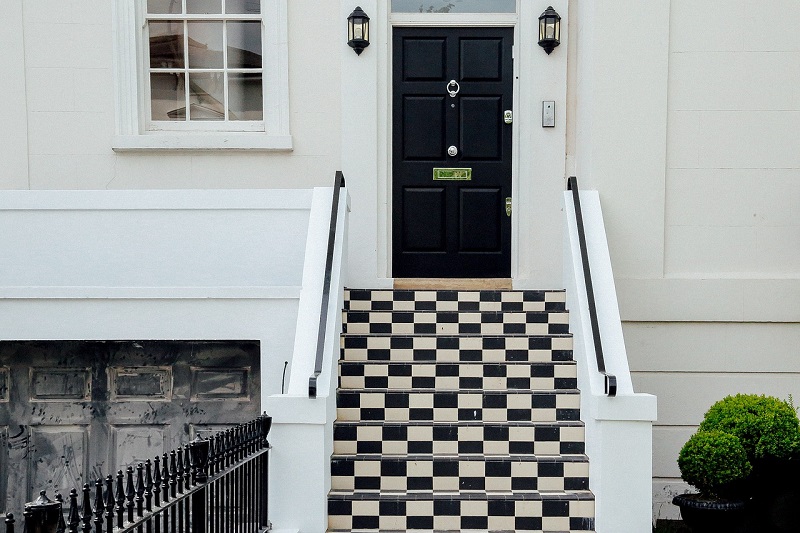As the official passageway into your home, your front door speaks volumes about who occupies the space inside. However, for many homeowners, taking the time to choose an appropriate entry door that fits the style of their home, adds value to their property, and is aesthetically beautiful is something they usually neglect.
Maybe it feels too overwhelming, or perhaps they forget that a front door can add or subtract to a home’s curb appeal. But, the ideal front door must be sturdy, yet aesthetically pleasing and gracious.
 |
| Front Door |
Keep in mind that replacing your front entry door (when it really needs to be replaced) is an advantageous undertaking as the value almost surpasses the actual cost. When it comes to finding a front door that fits your budget yet eclipses your expectations, you have many options – ranging from colours, design, materials, and safety. Here is how to choose the most suitable front door for your home.
1. First, talk budget and how much you are comfortable spending.
First and foremost, just like with any home renovation project, you and your housemates need to determine how much you are able (and are comfortable) spending. Home improvement projects are notorious for creeping over budget, due to delays or inaccurate cost planning at the start.
While it is possible to DIY a new front door, it certainly isn’t recommended, as it is easy to commit a pricey mistake that leads to having to reorder another door or hiring a professional to finish the installation.
You should consider replacing your front door as an investment and your budget should demonstrate meticulous planning and decision making. When determining the costs of your door, keep in mind the upfront costs vs. long-term benefits, maintenance requirements, weather protection and performance, and energy efficiency.
2. Second, consider the materials that are on offer.
There is no doubt that the material your door is made from is the primary element that will affect its appearance, durability and maintenance requirements. It will also determine the price of your door, so it’s essential to take some time to consider all the options.
For the most part, front doors are made of wood, steel or fibreglass, with many also offering panel styles with the option of adding glass. For an additional cost, these doors have decorative glass in a variety of patterns with bevels, textures and caming. Here are three materials to consider for your front door.
# Wood
 |
| Wooden Doors |
The most classic of front door options, authentic wooden doors have long been celebrated for their unique beauty. With intricate grain patterns and colour markings, wooden doors come in many styles and offer you the option to customise them with varying wood types, decorative glass, panel styles, historic accents and embellishments.
Due to their beautiful and natural look, and their warm and rustic appearance, wooden doors tend to be more expensive than doors made of other materials.
# Steel
The most affordable of the options, premium steel doors are extra durable, so you can trust that they won’t warp or crack and will undoubtedly resist denting. They also often include an insulated core to aid with energy efficiency. As steel doors have a smooth surface, their look is mostly limited to panel designs and paint colours.
# Fibreglass
Fibreglass doors have quickly gained a reputation as high-performing, energy-efficient doors. Featuring the realistic look of stained wood in a variety of grains, fibreglass doors are durable and easy to maintain and are offered at a range of price points. Not only do they have aesthetic appeal, but they also can be customised with a wide variety of panel styles, decorative glass and finish options, and are dent-resistant.
# Composite doors
Many of you may be asking, “what are composite doors?” As one of the newest offerings on the market, composite doors are quickly growing in popularity. Similar in appearance to that of a solid timber doors, but with all the advantages of contemporary low-maintenance materials, the new kid on the block has some impressive offerings!
With a solid foam and timber core, a robust glass reinforced plastic skin, and a highly-accredited frame, these doors are very effective insulators and fit frames precisely to eliminate draughts. Available in a range of styles to suit all properties, they are a fantastic choice for both front and rear entrances.
3. Third, remember that size definitely matters and everyone’s is different.
For the most part, a standard exterior entry door is 80 inches tall by 36 inches wide and almost two inches thick. However, depending on the style and age of your home, your particular entryway may require a taller, wider or thicker door.
When calculating the size of your door, make sure to include any sidelights or other decorative elements. If you’re uncertain about what front door size your home requires, don’t wait to contact a professional for some advice.
After you have considered these three things, it is then time to choose a style for your front door! This is the exciting, creative part as you are looking for one that complements the design of your home (while also adding curb appeal). Keep searching until you find one that represents you or your family’s personality. Every house and homeowner is different, so pick a front door that shows the world how unique you are!
AUTHOR BIO:
Carmen Velilla is an experienced Brand Manager currently overseeing the strategic development of multiple brands as part of the Epwin Group. She is an Associate Member of the Chartered Institute of Marketing (ACIM), specializing in Corporate Communication and Digital Marketing.
October 2, 2018
Leave a comment
